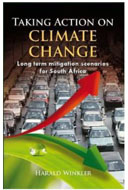Services on Demand
Article
Indicators
Related links
-
 Cited by Google
Cited by Google -
 Similars in Google
Similars in Google
Share
South African Journal of Science
On-line version ISSN 1996-7489
Print version ISSN 0038-2353
S. Afr. j. sci. vol.106 n.11-12 Pretoria Nov./Dec. 2010
http://dx.doi.org/10.4102/sajs.v106i11/12.468
BOOK REVIEW
Can the climate change bandwagon's piccolo player start conducting?
Tony Leiman
School of Economics, Faculty of Commerce, University of Cape Town, South Africa. email: mtony.leiman@uct.ac.za
Book Title: Taking action on climate change: Long-term mitigation scenarios for South Africa
Book Cover:

Author: Harald Winkler
ISBN: 978-1-919895-25-3
Publisher: Cape Town: UCT Press, 2010
The Kyoto Protocol, which has been directing global attempts to control climate change, is due to expire in two years' time. While it was hoped that the recent Copenhagen talks would provide a way forward, such hopes were dashed. Surprisingly, the South African delegation actually took on something of a leadership role at Copenhagen and exceeded many watchers' expectations in its proclaimed commitment to mitigating climate change.
After having read Harald Winkler's book, it is clear that the South African government had already demonstrated some commitment far ahead of the Copenhagen meetings. It initiated the process (which gave rise to the book) in 2006 by requesting scenarios on which long-term climate policy could be based – and which would give South African negotiators informed positions from which they could negotiate in a post-Kyoto world. Importantly, the group commissioned by government to undertake these scenarios had sufficient scientific and modelling expertise to provide a report which was both accessible to politicians and scientifically credible. The report written for government by Winkler's team provides the basis for this book.
At its heart is a set of scenarios, the focus falling on two extremes, 'Growth Without Constraints' (GWC) and 'Required by Science' (RBS). The former, a scenario with no constraints on greenhouse gas emissions, shows them growing by roughly 400% in the next 40 years. 'Required by Science' asks what would happen if South Africa had to reduce emissions to between 60% and 70% of their 2003 levels before 2050, in other words, if post-2012 South Africa had to join a world community which was genuinely committed to mitigating climate change.
The wide gap between the scenarios led the authors to treat the RBS option as the sole goal, while intervening scenarios such as 'Can-Do' and 'Could-Do' disappeared. While the use of extremes does show the full potential cost of mitigation, there is also an economic naïveté to it. In reality, South Africa is a net technology importer, much of it remarkably inappropriate to South Africa's endowments of resources, labour and capital. We are likely, willy-nilly, to follow the emissions paths set by the First World, China, and India. If they address climatic imperatives, then, by using their technology, so will we.
As the Club of Rome model1 showed, a scenario system that ignores markets will always be vulnerable. The MARKAL system used to model the two scenarios uses details of inputs and outputs for different energy technologies; it is fine for pre-set scenarios, but can make only limited accommodation for price changes. The authors have recognised this, but it is not clear that the book's readers will. Market forces could reduce the gap between scenarios and take some of the focus off the RBS option.
The question is, 'How much is cutting carbon likely to cost?' One of the book's most useful features is a mitigation cost curve, based on opportunities for curbing greenhouse emissions in commerce, transport, the residential sector, power generation, industry and agriculture. A rational economic policymaker wanting to match the emissions targets of industrial nations as cheaply as possible could begin with the cheap and effective (limits on sports utility vehicles and increased use of public transport), proceed through enhanced industrial efficiency and changes in energy generation, to subsidies on renewable energy systems and end with the least economically efficient (electric vehicles, biofuel subsidies, and hybrid cars).
Power generation is naturally central, especially given coal's currently dominant role. Both scenarios project the dominant use of coal in integrated gasification combined cycle systems and Koeberg-style pressurised water reactors – prophetically ahead of pebble-bed modular reactors.
The book is obviously based on a report, and the editing is still not complete in places. The information given is clearly presented and very useful. I personally think that they would have done us all a service by giving some indication of where they think we are likely to end up, rather than only the two extremes, and by stressing some of the collateral damage associated with some of these scenarios. One example is the focus on diesel minibuses, ignoring the associated air pollution. Another is the section on the water requirements of coal-fired power stations, which is very incomplete.
The work is good and the job done well, but, to be really useful, different questions should be asked. The team's unanimous decision that 'RBS is the only option' remains a real concern. A politically rational objective is to follow the paths of our major trading partners and the world's major greenhouse gas emitters. South Africa is no market leader and it would be economically irresponsible to set targets as if it were. It is not South Africa that needs to be persuaded of the RBS scenario, but the world's major powers.
REFERENCE
1. Meadows DH, Meadows DL, Randers J, Behrens WW III. The limits to growth. New York: Universe Books; 1972. [ Links ]
 Postal address:
Postal address:
School of Economics, Faculty of Commerce, University of Cape Town
Private Bag
Rondebosch 7701, South Africa














